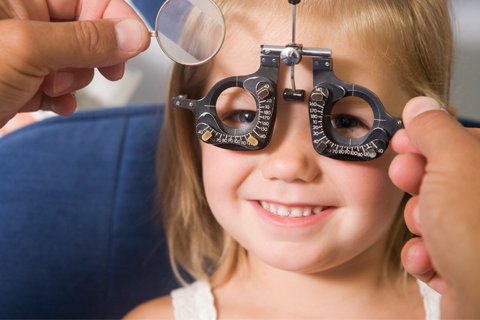
child eye exam
Dr. Stephanie Su is an optometrist at Visionary Eye Associates, a Rochester practice with locations in Brighton and Webster. Dr. Neil Henninger is the sole proprietor of Trumansburg Optical in a rural village outside of Ithaca , NY . Despite their geographical differences, the two eye doctors have quite a bit in common. Both are graduates of New England College of Optometry in Boston , MA where they began their residencies doing eye exams on students. Between them they have worked with thousands of children and their families. And each encourages parents to make sure their children receive regular eye exams from an optometrist or ophthalmologist to maintain optimal vision throughout their lives.
The Eye Exam Difference
Many parents want to know why their child needs to see a doctor of optometry if they already get an eye exam in school or at their pediatrician’s office. “What we do is way more comprehensive,” Su explains. “Our charts have the correct type of lighting, our machines are calibrated to check the child’s current prescription, and we also test extensively to determine the child’s overall eye health.” She adds that school tests are particularly problematic as kids often listen to the child in front of them reciting the letters and are able to memorize and repeat them, thus making it appear that they can see much better than they really can! Henninger adds, “An eye doctor will take a detailed patient and family health history before they examine the child’s eyes. Then they’ll check the patient’s visual function in a number of ways to make sure that the child perceives their world correctly. Eye doctors test for refractive errors like astigmatism and near and farsightedness. They will also look for signs of eye diseases such as tumors or congenital cataracts. An optometrist will test for colorblindness, depth perception, eye-hand coordination, and tracking, as well as checking the function of the child’s eye muscles.” Optometrists have a broad base of experience that allows them to identify a variety of visual problems. They can also write prescriptions for glasses, contact lens, and medications for eye infections or allergies and recommend vision therapies like patching for “lazy eye” or visual exercises for families to do at home.
When To Go
Most professional organizations like the American Optometric Association (AOA), which both doctors belong to, believe that kids should receive their first eye exam by the time they are three years old or, at the very latest, when they begin kindergarten and on a yearly basis after that until they reach adulthood. Su goes one step further, recommending that parents take advantage of the Infancy Program which offers children from ages six to thirteen months a free eye exam to ensure that the muscle movements in their eyes are developing correctly, that there is no functional difference between their two eyes, and that the child’s eyes are evolving properly. A great resource that Su recommends for parents who want to learn more about what to expect visually from their children at different ages is the “Good Vision Throughout your Life” section of the AOA website (www.aoa.org)
Preparation
What’s the best way for parents to prepare younger children for their eye exam? Su’s office has hand-held devices and games that they use, along with picture charts for kids that don’t know their numbers or letters yet. For children that dislike the eye drops required for dilation, she suggests that parents practice pulling up their child’s eyelids at home before the exam so they become familiar with the sensation.
Both doctors agree that older children tend to be more intrigued than nervous about the whole exam process and the complex machines used. It’s important for parents and caretakers to realize that children with special needs should also receive regular eye care and that many optometrists are proficient at examining both verbal and nonverbal children. Finally, Su adds that it’s essential for children with diabetes to have their eyes examined on a regular basis because, the longer they have diabetes, the greater their chance of an ocular manifestation that could potentially lead to a need for laser surgery or possibly even blindness. Something many parents may not be aware of is that the eyes are the only noninvasive place in the body where a doctor can see the patient’s blood vessels. Additionally, blood sugar fluctuations are directly correlated with changes in the child’s prescription. “One day they can see and the next day suddenly they can’t,” she says. Henninger agrees that anyone with diabetes needs to have an annual eye exam, whether a child or an adult. “The earlier that diabetic retinopathy is diagnosed, the better the chance of minimizing the damage it can cause,” he emphasizes.
Vision Care
There can be long-term social and academic repercussions for children whose visual problems go untreated both doctors say. Common signs that your child may not be seeing what other children are seeing include squinting, frequently closing one eye, repeatedly turning their head from side to side, or excessive rubbing. Su notes that a child with extremely poor eye-hand coordination may not be clumsy; she simply may not be able to see very well. Henninger advises parents that improper vision care in childhood can impact healthy sight over a person’s lifetime. A common issue for kids is sports-related eye injuries. Kids are naturally more physically active during the day than adults, placing them at higher risk for eye injuries. Impact resistant lens materials and frames made out of “memory metals” are two ways that parents can help their children avoid these, he says. Su adds that any child who is hit in the eye while playing sports should be seen and dilated by an optometrist because, if there’s enough force involved, there can be a retinal tear or retinal detachment that could require treatment.
Another issue for active children is UV radiation and glare exposure which youngsters are more vulnerable to, even on cloudy days. Since children tend to spend lots of their time outdoors, the amount of UV exposure they get can increase the chance of developing cataracts or retinal damage as they age. Henninger explains that, just as sunscreen can protect children’s skin from too much exposure, antireflective coating on their lenses, which minimizes reflections, or transition lenses, which can change from clear to dark in UV light, can protect children’s eyes. Su observes that even infants can wear sunglasses (like Baby Banz) to prevent future damage to their sight.
In the case of eye infections, both optometrists recommend that children be brought to them instead of a pediatrician who may automatically prescribe an antibiotic when it’s not really necessary. “We can diagnose whether the condition needs treatment,” Su says. “Sometimes the eye can heal itself or be treated with something simple like a hot compress.”
An excellent way to maintain your family’s eye health is to make your appointments together at the same time each year, just like changing the batteries in your smoke detector. Su says she often sees five or six family members in one appointment, which works well for everyone involved. “It shows your kids that you feel regular eye care for the whole family is important,” she notes. +
Sue Henninger is the parent and a regular contributor to Rochester Area & Genesee Valley Parent Magazine. She lives in the Finger Lakes Area. Contact her at
su*@fi***************.com
or www.fingerlakeswriter.com
// Who’s Who in the Eye World? //
- Optician Makes eyeglasses from a prescription written by an optometrist or an ophthalmologist. An optician can teach patients about contact lens insertion and removal techniques.
- Optometrist (OD) A licensed doctor who has graduated from a four year college of optometry in addition to having a four year undergraduate degree. An optometrist can perform comprehensive eye exams and diagnose and treat eye conditions.
- Ophthalmologist (MD) A licensed doctor who has attended four years of undergraduate college, four years of medical school, and has had a residency of two or more years in ophthalmology. An ophthalmologist can give comprehensive eye exams, diagnose and treat eye conditions, and perform eye surgery, such as Lasik surgery.
Views: 0






